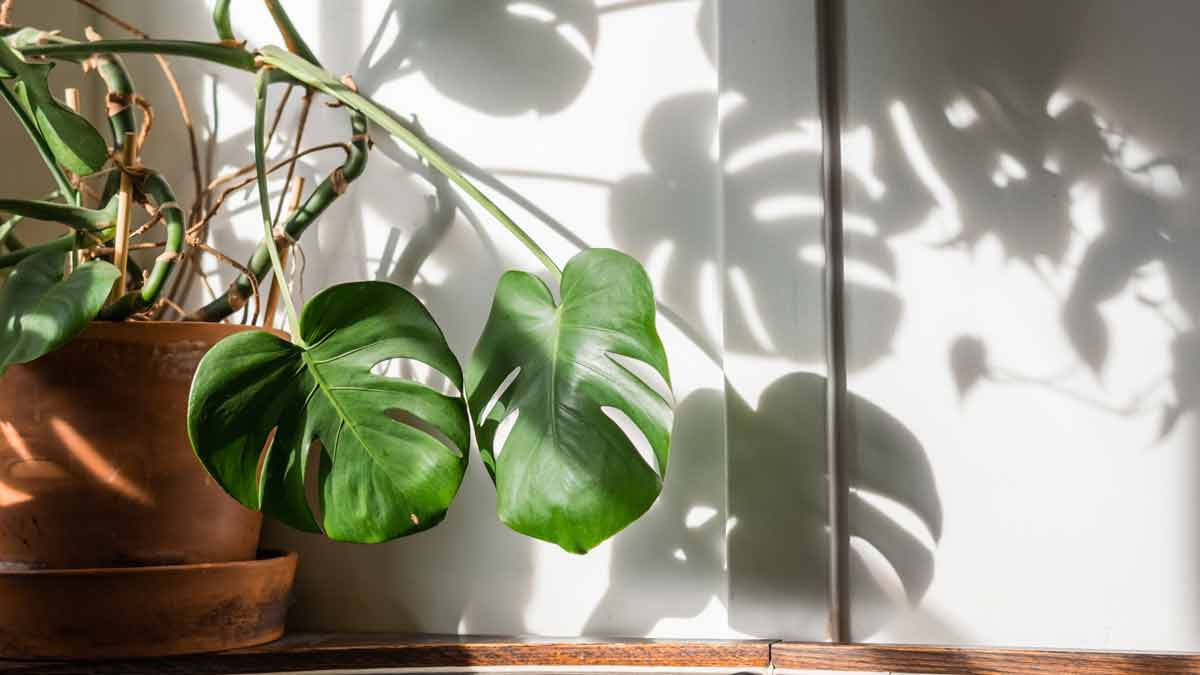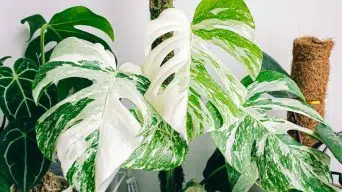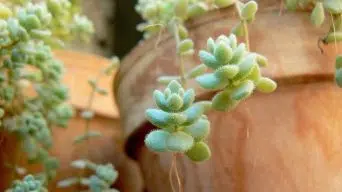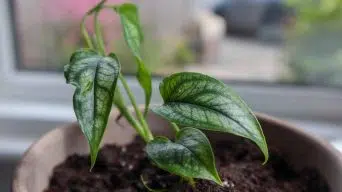Monstera aerial roots grow from the stem above the ground, providing support and absorbing moisture. Keeping them healthy benefits the plant’s overall health, and they can be used for support. They can also be trimmed if they are too long or unsightly.
Monstera, more commonly known as the Swiss cheese plant, is an evergreen climbing vine that has become hugely popular in recent years due to its striking foliage and easy-care requirements.
The leaf of the evergreen climbing vine has become a popular feature in many gardens, with its glossy, deep green foliage providing a stunning backdrop to any outdoor space and requiring minimal care to keep it looking lush and healthy.
But did you know that this tropical plant also produces aerial roots?
These unique root systems are a fascinating feature of Monsteras. They allow them to climb trees and other structures in their natural habitat.
In this article, we’ll delve into what aerial roots are, what can you do with them, and how you should care for them.
What Are Monstera Aerial Roots?
Monstera plant’s aerial roots are a type of root that grows above the ground level. They are also known as air roots or adventitious roots.
Unlike underground roots, or subterranean roots, that grow in soil, aerial roots absorb moisture from the air.
These Monstera roots can be found in many different plant species, including Monstera plants.
Monstera aerial roots typically start as small knobs that grow out of the plant’s nodes.
Over time, they can reach several feet long and become thick and woody. These roots have a rough texture and are usually brown in color.
Why Monstera Plants Grow Aerial Roots
Monstera plants grow aerial roots for several purposes.
One primary function of these roots is to provide structural support for the plant as it climbs. In nature, Monstera plants utilize their aerial roots to attach to tree trunks, providing stability and enabling them to reach higher for better exposure to light.
Another significant role of Monstera’s aerial roots is to absorb moisture from the air. In the plant’s native tropical habitats where humidity levels are high, aerial roots allow Monstera plants to extract moisture, supplementing their water intake.
Additionally, aerial roots aid in anchoring the plant within its growing medium. When cultivated in potting mix or other substrates, these roots play a vital role in maintaining the plant’s stability and preventing it from toppling over.
Aerial roots are a crucial aspect of the growth strategy for these distinctive plants. Monstera vines use these roots to attach themselves to nearby structures like trees, walls, or poles, providing support and stability for climbing and spreading. This allows the plant to access more sunlight and nutrients, promoting optimal growth and vitality.
Understanding the purposes of these specialized roots helps in providing appropriate care for your Monstera plant and fosters a deeper appreciation for its beauty in all its aspects.
What To Do With Aerial Roots
Monsteras aerial roots are an interesting and sometimes confusing feature of this popular houseplant.
These dangling, hairy-looking appendages can be intimidating for first-time Monstera owners, but don’t worry; there’s nothing to be afraid of!
In fact, with a bit of knowledge and understanding, you can help your plant thrive.
Here are some things you can do with Monstera aerial roots to make the most of this unusual but beneficial feature.
Leaving the Roots Alone
The first, and often simplest, way to deal with Monstera aerial roots is to leave them alone.
These types of roots naturally grow outwards and downwards, so as long as they’re not causing any damage or blocking sunlight from other parts of your plant, there’s no need to do anything.
Your Monstera can use its aerial roots to climb to brighter light, absorb moisture from the air, and anchor itself into its growing medium.
Simply let them do their job and enjoy watching your plant thrive!
If you choose to leave the aerial roots as is, there are a few things you can do to make them look more aesthetically pleasing.
One option is to wrap them around a moss pole or other support structure. This will make the plant look more attractive and provide additional support for the stems and leaves.
Another option is to trim any dead or damaged portions of the aerial roots. This will help keep your plant healthy and prevent any potential issues from arising.
It’s important to note that while leaving aerial roots intact may benefit your vining plant, it’s not always necessary.
If you prefer a neater appearance or don’t have a support structure for your plant to climb on, it’s perfectly fine to trim away any excess growth.
Trimming Back Aerial Roots
If you’re dealing with Monstera aerial roots that are starting to take over your plant or just don’t fit with your aesthetic preferences, trimming them back is a simple solution.
But before you start snipping away, there are a few things you should know.
It’s important to understand that cutting off aerial roots will not harm the plant.
In fact, these roots will often grow back quickly after being trimmed. So if you’re worried about damaging your beloved Monstera, rest assured that it can handle a little pruning.
How To Trim Them Back
To trim back unsightly or overgrown aerial roots on your Monstera plant, you’ll need a sharp pair of pruning shears or scissors.
Ensure they’re clean and sterile to prevent any potential infections in the plant.
When cutting back aerial roots, it’s best to make clean cuts as close to the main stem as possible without damaging it.
This will help promote healthy regrowth and prevent any damage to the rest of the plant.
Once you’re done trimming, remove any excess leaves or debris to keep the area clean and tidy.
It’s also a good idea to mist your plant with water afterward, as this will help keep it hydrated during the healing process.
Training Aerial Roots
Training Monstera aerial roots is a great way to keep your plant tidy while allowing it to use these appendages for support and hydration.
The primary purpose of these roots is to allow the plant to climb and provide structural support.
Therefore, it is important to train them properly so that your monstera can grow strong and healthy.
Types of Support Structures
There are several types of support structures that you can use for your monstera’s aerial roots:
- Moss pole: These are a popular choice among plant enthusiasts as they mimic the natural environment of the monstera in the wild. Moss poles comprise a wooden stake covered in sphagnum moss that provides a surface for the aerial roots to attach themselves to.
- Trellis: These are another option for providing support for the aerial roots. Trellises come in various shapes and sizes and can be made from materials such as wood or metal.
- Wall mount: If you don’t have space for a moss pole or trellis, wall mounts are a great alternative. These allow you to attach your monstera directly onto a wall or other vertical surface.
How to Train Aerial Roots
Now that you know about the different types of support structures available, let’s talk about how to train your Monstera to climb:
- Choose a support structure: The first step is to choose the correct type of support structure for your monstera. Consider factors such as space and aesthetics when making your decision.
- Securely attach the structure: Make sure the support structure is firmly attached to provide adequate support for your plant. If you’re using a wall mount, use screws or nails to secure it in place.
- Use sphagnum moss: Cover the support structure in sphagnum moss, as this will provide an ideal surface for your plant’s aerial roots to attach themselves to. This will help them grow strong and healthy.
- Guide the aerial roots: Once your support structure is in place, gently guide the plant’s aerial roots toward it. Be sure not to pull them too hard or damage them in any way, as this can cause permanent damage.
- Secure with ties: To keep the aerial roots securely attached, use soft plant ties or thick string to bind them in place while they take root and form a strong bond with the support structure.
- Trim away excess growth: If you notice any overgrowth of aerial roots that are starting to take over your plant or just don’t fit with your aesthetic preferences, trim them back using a sharp pair of pruning shears or scissors. Make sure you make clean cuts as close to the main stem as possible without damaging it.
- Monitor aerial root growth: As your monstera grows, monitor its progress and adjust its position on the support structure accordingly.
By following these steps, you can ensure that your Monstera’s aerial roots are safely and securely trained. This will create a strong and healthy foundation for your plant to grow tall and lush.
Knowing how to train Monstera aerial roots is an essential part of successful and beautiful indoor gardening!
How to Care For Monstera Aerial Roots
The aerial roots of Monstera plants are a unique and beneficial feature for any home. These roots help support the plant, absorb moisture from the air, and even have an aesthetic value.
Learning to care for Monstera plants properly means understanding the needs of the aerial roots, which can be a bit more complex than caring for the main stem and foliage.
Here are some tips on how to care for Monstera aerial roots:
- Provide adequate humidity: Aerial roots need high humidity levels to absorb moisture from the air. To achieve this, mist your plant daily or use a humidifier.
- Optimize air circulation: Aerial roots also need fresh and well-circulated air to thrive. Make sure the area around your plant is free from obstructions that can block airflow.
- Give extra nutrition: If you notice any discoloration or stunted growth in the aerial roots, it could be a sign that they’re not getting enough nutrients. Try adding a nutrient-rich fertilizer to your watering routine.
- Control temperature fluctuations: Temperature fluctuations can cause stress for Monstera plants, so try to keep your home at a consistent temperature and away from any drafty windows or vents.
- Provide plenty of indirect light: Monstera aerial roots need good light to grow, but direct sunlight can damage them. Aim for bright indirect light and monitor your plant’s growth.
- Water the soil, not the aerial roots: Remember that monstera aerial roots are made to absorb moisture from the air, so try to avoid overwatering them. Instead, water your plant’s soil regularly but not excessively.
- Check for pests: Aerial roots are especially susceptible to pest infestations, so keep an eye out for any signs of damage or discoloration. If you spot any, treat the plant immediately with insecticidal soap or spray.
- Trim away overgrowth: If your plant’s aerial roots are becoming too long or taking over the plant, you can trim them back using a sharp pair of scissors. Make clean cuts close to the main stem without damaging it.
Following these steps, you can provide the best care possible for your Monstera’s aerial roots and ensure they remain healthy and strong!
Aerial Roots Common Problems
Although Monstera aerial roots are essential for the plant’s growth and stability, they can also cause various problems.
Here are a few issues to look out for:
- Root rot: Too much moisture and soggy soil can lead to root rot in plants, especially in the aerial roots. Make sure to water your plant regularly but not excessively to avoid this issue.
- Pest infestation: As mentioned before, aerial roots are susceptible to pest infestations like mealybugs or spider mites. Monitor your plant closely and treat any pests immediately with insecticidal soap or spray.
- Overgrowth: Aerial roots that are too long or taking over the plant can be a sign of overgrowth. Trim them back carefully using scissors, and make sure to leave some extra space for new growth.
- Exposure to too much light: Direct sunlight can scorch and damage aerial roots, so keep your plant away from any windows or vents that might be letting in too much light.
- Dry or shriveling roots: If your Monstera’s aerial roots start to shrink or appear dry, it could be a sign of insufficient humidity. Try misting the plant more often or using a humidifier in the room.
Overall, taking care of Monstera aerial roots is essential for the health and growth of your plant. By following the tips above and keeping an eye out for any potential issues, you’ll be able to provide the best possible environment for your Monstera’s aerial roots!
How to Repot Monsteras with Aerial Roots
Repotting a Monstera with aerial roots is a bit trickier than repotting other plants, but it’s still doable if you’re careful.
Before we dive into the steps to repot your Monstera plant, let’s talk about the tools you will need.
Tools Needed for Repotting
To repot a Monstera with aerial roots, you will need the following items:
- A larger pot: When selecting a new container for your plant, it is important to choose one that is at least 2-3 inches larger than the current pot.
- Potting soil: Choose a well-draining potting mix that has good aeration and moisture retention.
- Pruning shears or scissors: Use sharp scissors or pruning shears to trim away any dead or overgrown roots.
- Moss pole or stake: If your plant is vining, you’ll need a moss pole or stake to provide extra support.
- Sphagnum moss (optional): Sphagnum moss can help retain moisture in the soil and provide extra support for the aerial roots.
- A pair of gloves: Wear gloves to protect your hands while handling the plant.
Steps for Repotting Monstera Plants
Now that you have all the necessary tools, let’s get started on how to repot your Monstera plant with aerial roots:
- Water Your Plant: Watering your Monstera before repotting helps loosen up the soil and makes it easier to remove from the pot. Ensure not to overwater, as this can make it difficult to handle the plant during repotting.
- Remove Your Plant from Its Current Pot: Gently turn your pot upside down while holding onto the base of the stem of your plant. Tap around the edges of the pot until you feel it loosen up. Once loose, gently pull out your entire plant from its current pot.
- Inspect Roots: Inspecting roots is an essential step in determining if there are any signs of root rot or disease. If there are any brown or mushy roots, cut them off using pruning shears or scissors.
- Prune Aerial Roots: If there are any long or unruly aerial roots, prune them back using pruning shears or scissors. This will help make it easier to handle during repotting.
- Add Fresh Soil Mix: Add fresh soil mix into your new pot until it reaches about one-third full.
- Place Your Plant in New Pot: Place your plant in its new pot and fill in around it with fresh soil mix until it reaches about one inch below the pot’s rim. Make sure to use a pot with drainage holes to prevent root rot.
- Place a support stake in the pot: If you want to keep your plant upright, place a support stake in the pot. This will provide extra stability and help with the proper growth of aerial roots.
- Add Sphagnum Moss: If desired, add some sphagnum moss around the base of the stem and on top of the soil to help retain moisture.
- Don’t Water Your Plant: After repotting, don’t water your plant for at least a few days. This gives the roots time to settle in and adjust to their new home.
- Place in Indirect Light: Once you have repotted your plant, place it in an area with indirect light. This will help encourage growth and root development.
- Keep an Eye Out for Potential Issues: After repotting, it’s important to watch for any potential issues that may arise over time.
Can You Use Aerial Roots for Propagation?
Are you wondering if you can propagate Monstera aerial roots?
Well, the short answer is no. Aerial roots alone cannot be used for propagation. This is because aerial roots are not designed to spread in the same way that plantlets or stem cuttings can.
Aerial roots form a natural part of the Monstera life cycle and serve many purposes, such as assisting with climbing and moisture absorption.
These roots are not suitable for producing new plants alone, although they can be used in conjunction with other methods to encourage growth.
Propagation requires a piece of the stem that includes at least one node and one aerial root.
The node is where new growth will emerge, and the aerial roots will help anchor the Monstera cutting in soil or water.
But don’t worry! If you have a Monstera plant with aerial roots, it’s still possible to propagate it using stem cuttings.
Monstera Propagation Methods
When propagating Monstera, there are three main methods to choose from: water propagation, soil propagation, and air layering.
Water Propagation
Water propagation is a popular method for propagating Monstera plants.
To do this, place your stem cutting in filtered water, submerging the node and aerial root.
Change the water every few days to keep it fresh and prevent bacteria growth.
After several weeks, you should start to see roots forming from the node and possibly even new leaves emerging.
Soil Propagation
Soil propagation is another option for propagating your Monstera plant from a cutting.
To do this, prepare a pot with well-draining soil and insert your stem cutting into the soil to cover the node and aerial root.
Water thoroughly and keep the soil moist but not waterlogged. Place your pot in bright indirect light and wait for new growth to emerge.
Air Layering
Air layering is another technique for propagating Monstera plants that involves encouraging roots to form while still attached to the parent plant before separating them as an independent plant.
To do this, locate a stem at least 8 inches long and gently remove a quarter-inch of bark from the section you wish to propagate.
Then, wrap sphagnum moss around the area and secure it with plastic wrap. After several weeks, roots should form in the moss, and your cutting can be detached from the parent plant.
Final Thoughts
Houseplants, such as Monstera, are becoming increasingly popular due to their intriguing features, like aerial roots, making them a great addition to any home. They provide a unique and eye-catching display that is sure to liven up any living space.
While not necessary for a healthy Monstera, aerial roots can provide support, stability, and aid in moisture absorption.
Vining plants like Monstera are an excellent way to add a touch of greenery to your home. They can be trained to climb up walls and trellises, creating a lush and vibrant atmosphere that can be enjoyed for years to come.
If you choose to keep your Monstera outdoors, you can take advantage of natural sunlight and fresh air to help it thrive.
You’ll also enjoy the beauty of your plant in its natural environment and the satisfaction of watching it grow and flourish in the great outdoors.
Ultimately, the decision to use aerial roots or not is yours. Either way, you’ll have a stunning plant to admire.
Happy growing!







